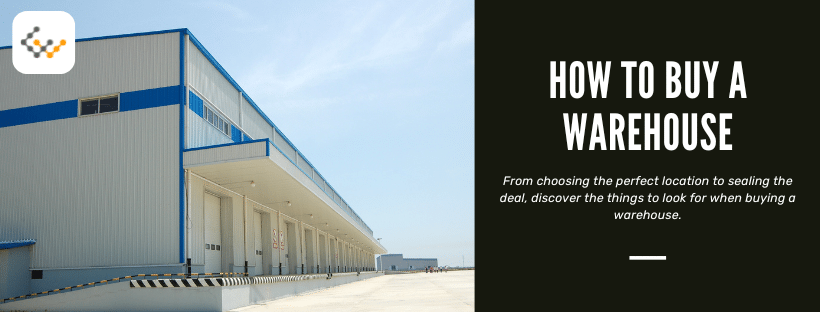How to Buy a Warehouse: A Guide to Warehouse Investment

Warehouse space is valuable for many organizations. Due to the increased demand for consumer online purchases rather than in-store purchases, there has been a much higher demand for high-quality, accessible warehouse space in key markets. For investors, it is critical to determine if there is profit potential in purchasing a warehouse to meet revenue goals in a highly competitive industry sector.
What is Considered a Warehouse Property?
Warehouse property could include any combination of land with buildings, improvements, fixtures, and structures designed to store and transport goods. It is typically commercial property used to store inventory. However, many organizations will also incorporate other tasks within that space, including truck loading and unloading and logistics management. Industrial warehouse space focuses more on raw material storage for manufacturing or construction.
Answer a few questions and get custom mortgage quotes. We'll match you with offers from our network of 650+ lenders.
Types of Warehouse Property
Numerous specific types of warehouse property investing options exist. Investors should consider local demand and costs before choosing any of these types:
- E-commerce fulfillment warehouses (those that operate as a distribution center)
- Storage warehouses
- Automated warehouses (which can serve any function but include high-end technology)
- Public warehouses
- Technology warehouses (used for tech storage solutions)
- Flex space warehouses (these may combine office and warehouse spaces)
- Climate-controlled warehouses (better for more sensitive product storage)
- Foodservice warehouses (which must meet specific requirements to allow for food storage)
- Pick, pack, and ship warehouses (those that offer space for workers to pick materials, package them, and ship them )
- Self-storage(can be commercial or consumer)
- Raw materials warehouses (those designed specifically for raw material storage for construction or manufacturing
In addition to the functional types of warehouse structures, it is also important to consider the classification of the building. Many communities will label properties based on industrial use (Class B, C, or D). While industrial buildings, including those once used for manufacturing, are not always warehouse options because there are so many defunct properties in various industrial cities, some investors have been purchasing and converting them for a faster route to getting the property established.
Why Invest in Warehouses?
Warehouse investment can provide promising results for many investors who are looking for a more hands-off style of leasing. Key to this decision is knowing what is necessary and beneficial within the local community. Consider both the pros and cons.
Pros of Investing in a Warehouse
- Demand is likely to remain: In most larger cities and rural areas near highways, warehouses tend to be a solid investment option because demand remains high. Experts expect demand to continue for years to come.
- Size means higher profits: Because of the size of most warehouses, property owners can typically charge larger rents for the property. Most are leased by the square footage.
- Less volatility: Unlike commercial spaces, warehouse space is less volatile based on economic conditions. Long-term leases tend to be much easier to manage overall.
- Many are triple net leases: This means the tenant is responsible for the maintenance, taxes, and insurance on the property, which means property owners have less to do to manage the investment.
- Appreciated value over time:
Most warehouses will remain in demand over a long period and don’t require numerous upgrades to keep them in demand.
Cons of Investing in a Warehouse
- Vacancy risk: Depending on location and other factors such as condition, some properties may suffer from vacancy risk. Investors must consider competition and location carefully to determine the vacancy risk and overall long-term demand.
- Single-tenant risk: Though some warehouses have multiple tenants, many will become single-tenant properties. This creates a concern if that company moves out, meaning the property is either fully rented or empty.
- Modernization needs: There are some situations where automation and technology may require updating the infrastructure of the property to meet the new tenant’s needs.
How Much Does It Cost to Set Up a Warehouse?
One of the most important decisions for investors is the cost of setting up a warehouse. This will differ based on numerous factors, including the type of warehouse, the size, age, and state, and whether or not the project is being built from the ground up. Typical costs range from $55 to $70 per square foot. This does not typically include land purchase or grading/preparation work. In some areas, costs can be as low as $20 per square foot for very basic systems.
6 Things to Consider When Buying a Warehouse
To determine the value of investing in a warehouse, investors must consider the following:
- Highest rate of return: This type of property tends to offer the highest rate of return, depending on location.
- Location factors: Location matters, especially when it comes to ecommerce buildings that need access to highways. Distribution companies near larger populations, for example, are critical.
- Lease type: Depending on the objectives in any given area, investors should consider various lease structures, with a triple net lease being the most common option.
- Overpaying upfront is costly: Those considering a move into this market may be tempted to buy at any price to get into the market. However, overpaying means long-term catch-up. Buying at the right price is often beneficial.
- Building or buying are options: Since it does not take long to construct a warehouse, those with available land and building allowances may wish to build brand new from the ground up.
- Features matter: Options like parking lots, loading docks, and utilities increase value, as do maintenance costs. Features like climate-controlled properties and those with ramps or on-site tech can also increase rental income and demand for the property.
How to Evaluate the Value of a Warehouse
The evaluation of any real estate purchase takes due diligence, which factors in all aspects of costs and operations. Numerous factors must be considered to determine an accurate value of these properties. There are several ways to value a property, specifically warehouses:
- Cost Approach: This strategy is the most common. The appraised value is based on the cost of rebuilding the warehouse from the start. Depreciation is also factored into this process. If no other comps are available, this method is one solution.
- Income Approach: For investors, the income approach is beneficial because it determines the value of the property based on the value of leases to tenants. This includes the net operating income that the property is likely to generate, discounted back to its present value.
- Market Approach: The market approach enables the valuation of the property based on recent sales of nearby properties that are similar in function and size.
Is it Worth Investing in a Warehouse?
There is value in investing in warehouses. The amount of that value is dependent on multiple factors, including the location and demand within that area. In areas where there is demand and opportunity, warehouse investing, which is priced well, can be beneficial. Factors that make it a good investment include:
- Long-term tenants, often staying 9 to 15 years
- Lower cost for construction if building from the ground up
- Shorter time to construction, generally six months in many areas
Wrapping Up
Investors looking to take advantage of the increased demand from consumers for e-commerce shopping may wish to invest in warehouse space. In the right environment and the most modern designs, these properties can be highly desirable to today’s investors.

